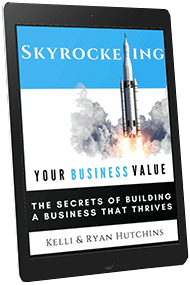
4 Steps to Obtaining an SBA Loan
Let’s talk about how to obtain an SBA loan. Over the past couple of years, I have spoken to over 300 SBA lenders. In doing so, I gained a better understanding of the differences between financial institutions. I also learned how each lender identifies and goes after their target market. Though these conversations were intriguing, two points were always brought up:
- Educating small business owners and buyers of small businesses about SBA loans.
- Being prepared for the SBA loan process.
We are going to focus on the second point; acting as a step-by-step guide to obtaining an SBA loan. Peak Business Valuation, business appraiser works with SBA lenders across the country. We specialize in providing SBA business valuations. For questions, schedule your free consultation.
How to Obtain an SBA Loan
The first thing we will discuss is how to get an SBA loan. For illustration purposes, I will use the story of a previous client we will name Mary. Mary owned and operated a bookkeeping business. Very few people share the same passion as Mary, especially for a bookkeeping business. Because of this passion, Mary came to me with the idea of purchasing a bookkeeping business in a neighboring community. Her excitement of expanding her business was soon followed by questions. “How should I go about structuring the acquisition? What is the best way to integrate and transition existing clients? How am I going to finance this acquisition?”
The best answer to these questions seemed to be financing the acquisition through an SBA loan. From here, I explained the following 4-step process for obtaining an SBA loan.
4 Step Process to Obtain an SBA Loan
These steps are:
- Qualifying for an SBA Loan
- Selecting an SBA Lender
- Gathering the Necessary Documents
- Completing the Required SBA Forms
In the following paragraphs, we look at these steps in more detail.
1. Qualifying for an SBA Loan
Prior to securing SBA financing, Mary and I discussed whether she qualified. The SBA documents the qualifications for a borrower. It is worthwhile to consider the SBA’s qualifications as well as the lenders. As such, each bank has its own set of guidelines to follow.
Mary and I considered her eligibility requirements for an SBA 7(a) loan. These loans are used for various reasons. They can include funding working capital requirements, purchasing another business, or purchasing commercial real estate.
Primary SBA Loan Qualifications
|
Credit Score: |
A credit score of at least 680 for all primary business owners. |
|
Down Payment: |
10 percent or more depending on the purpose of the loan. |
|
Collateral: |
The more business/personal collateral brought to the table, the easier the loan process will be. |
|
Operating Time as a Business: |
Two or more years of operating experience are required. |
|
Repayment Ability: |
A debt service coverage ratio of 1.25x. |
|
Business Credit Background: |
No delinquencies or defaults on debt obligations to the U.S. government. |
|
Nature of Business: |
The business operates as a for-profit entity. It is incorporated in the United States. In addition, the business engages in an industry that is eligible. |
2. Selecting an SBA Lender
Next, Mary and I looked into the SBA lenders available. I have worked with both direct lenders and loan brokers. As a result of that, we chose to focus on direct lenders. Direct Lenders include banks, credit unions, and non-bank SBA lenders. One of the most covenanted designations for a direct lender is the SBA Preferred Lenders Program (PLP). PLP lenders are able to process SBA loans more quickly than the Certified Lenders Program (CLP).
When vetting SBA lenders, Mary and I narrowed down a list of potential lenders with the following questions in mind:
- Lender’s total SBA volume and industries worked with
- Lender’s average SBA loan size
- Whether or not the Lender classifies as a PLP
- Standard turnaround time for pre-approval and funding
- Funding terms
At the end of the day, Mary selected an SBA lender she looked to as an advisor to the business. For more information, see Finding an SBA Lender.
3. Gathering the Necessary Documents
Gathering the necessary documents to complete the application is crucial and potentially timely. Luckily, Mary was organized and prepared with the following documents:
- 3 years of historical personal tax returns
- 3 years of historical business tax returns
- Interim balance sheet and income statement for the business
- Projected financial statements (one to two years if applicable)
- Purchase agreement
More documents may be required, but I have included the main documents we provided to the lender. For questions, schedule a free consultation with Peak Business Valuation, business appraiser.
4. Completing the Required SBA Forms
SBA loan applications vary by lender. They typically request basic information about the nature of the business as well as the intended purpose of the loan. Most SBA loans require the following forms:
- Borrower Information Form – SBA Form 1919
- Statement of Personal History – SBA Form 912
- Personal Financial Statements – SBA Form 413
- Fee Disclosure Form and Compensation Agreement – SBA Form 159
- This form was required because Mary had hired me to assist with the loan application. The form details how much was paid for the services rendered.
5. SBA Loan Application Timeline
Last, is the loan application timeline. Like any loan process, the SBA loan process is very detailed. However, over the past decade, lenders have been able to close SBA loans in as few as 30 days. That is remarkable! Mary and I were able to secure an SBA loan in 31 days.
SBA Loan Timeline
- Preparation of SBA Application – This included the completion of the above named 4 steps which took approximately a week.
- Letter of Intent – Upon completion of the application, the lender provided a letter of intent. This documented how much Mary qualified for. It also detailed the terms of the loan. Mary submitted a signed letter of intent along with a small deposit.
- Underwriting – The underwriting process varies by business and lender. In my experience, underwriting takes between 2 to 3 weeks. It is based on the need for further verification of financials and plans for loan proceeds. Mary’s experience with the underwriting process took about two weeks.
- Commitment Letter – Upon completion of the underwriting, a commitment letter outlining the terms of the loan and remaining steps were presented. Mary completed this step upon receiving the commitment letter. An additional deposit was required by Mary at this point. This deposit is typically $5,000 or 5 percent of the loan. It also counts against the down payment.
- Closing – During the closing of the loan, terms are finalized and loan agreements are signed by each party. This process took Mary less than a week. She was required to pay closing costs as well as SBA guarantee fees. The lender in return disbursed the loan proceeds.
Conclusion
In conclusion, working with an experienced SBA lender can make this process much easier and faster. SBA loans represent a government program. This means small business owners know beforehand how to prepare and secure a loan quickly. See also, Choosing an SBA Lender.
With the acquisition of the bookkeeping business, Mary was on her way to building a more sustainable business model. My experience with Mary provided a great learning experience about the SBA loan process. It also gave me a clearer picture of the mission of the SBA – helping small businesses to succeed.
SBA loans provide a great source of financing for small companies. If there is a possibility to grow one’s business with the assistance of an SBA loan, consider and look into an SBA loan. For more information, schedule a free consultation below. Peak Business Valuation, business appraiser, would be happy to help.
Schedule Your Free Consultation Today!
